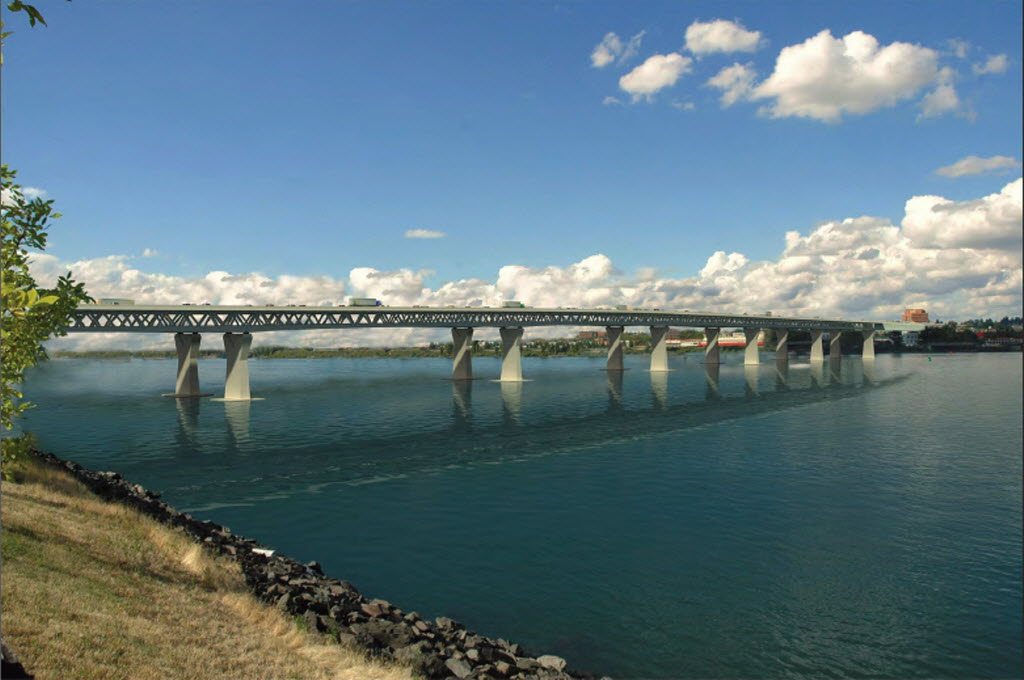Agency has Columbia River Crossing funding concerns
PORTLAND — One casualty of the coming federal budget crunch could be a new $3 billion bridge carrying Interstate 5 across the Columbia River.
At best, its sponsors acknowledge, the bridge project is going to take another whack. At worst, the sponsors say, are options they’re not ready to consider, including shelving $130 million worth of plans until the nation’s balance sheet looks better or scaling back the project.
The current I-5 bridge linking Oregon and Washington is considered at risk in an earthquake, and its tie-ups infuriate commuters and truckers.
Proponents of a replacement say the nation can’t afford the delays and risk at a critical transportation link: I-5 from Mexico to Canada is the economic spine of the West Coast, not only moving goods and people but also serving as a magnet for new jobs.
However, hours after the House voted last week for the debt ceiling bill, Oregon Rep. Peter DeFazio, a senior Democrat on the House transportation committee, was angry at Republicans, as well as the Democratic president. And he was pessimistic about the chances for the one-third share of the bridge costs the federal government was expected to bear.
“I would say that there is a very, very, very, very grim prospect for transportation investment with these people in charge and Obama in the White House, since he won’t stand up to them,” DeFazio told The Associated Press.
He said Republicans want to cut current transportation spending by about a third, leaving little room, if any, for new projects.
In the Northwest, sponsors said they were confident that the bridge wouldn’t be shut out entirely, and that little about a new transportation bill is settled.
Contacted by The Columbian on Sunday evening, Columbia River Crossing Director Nancy Boyd said, “I think we are still in a sobering situation financially, but also a very sobering situation from a transportation needs standpoint. … What we’re doing is thinking through very logically what these transportation needs are.”
Boyd said the process of planning for a new bridge must continue because, “The need is not going away.”
Oregon Gov. John Kitzhaber said, “I think we need to assume there’s going to be fewer resources.”
Kitzhaber has called for bridge construction to begin in 2013. He was elected with strong support from trade unions eager to build it. He’s also courted business interests, who are pushing the project, and he has long ties to officials at the Port of Portland, a key proponent.
“The starting point is: Nothing looks good,” said Mark Rupp, who directs operations for Washington Gov. Chris Gregoire in the nation’s capital. “But we don’t know at the end of the day where the cuts are going to be taken from.”
Aides to the House transportation committee chairman, Republican Rep. John Mica of Florida, didn’t return phone calls.
The current bridge consists of two spans, one dating to 1917, the other to 1958.
Plans for replacing them are ambitious. Six lanes of vehicle traffic would be expanded to 10. Portland’s light-rail mass transit would be extended into Vancouver in Washington. Pedestrians and bicycles would get more space.
The price tag reflects the ambitions, and has long been in question.
One round of budget cutting got the cost under $4 billion. This spring, to cut more and resolve a divisive aesthetic question, Kitzhaber and Gregoire stepped in to declare the bridge’s design would be functional and proven rather than striking and innovative.
Most recently, in an analysis Kitzhaber requested, Oregon State Treasurer Ted Wheeler found formally what project critics had said for years: The traffic assumptions the project’s planners relied on were too optimistic.
That means, said Wheeler, the toll revenues expected to cover about a third of the bridge’s cost would be way lower than forecast — by $500 million or so.
Kitzhaber responded by asking for options to stretch out the construction timetable, a solution he and aides turned to again last week.
The project can’t be built without federal money, and given the money already spent, it’s not time to start scaling back, said Patricia McCaig, Kitzhaber’s campaign director and now his top adviser on the bridge.
“We still have to fundamentally move forward with a project that looks like this,” McCaig said.
The federal dollars aren’t the only sources of uncertainty about the financing. Neither state legislature has figured out how to raise the $450 million each state is expected to pony up.
There’s also an important vote next year in Clark County on mass-transit financing. Although commuters on the Washington side face some of the worst delays, opposition is strong to two key elements of the bridge, tolls and the light-rail expansion.
Portland economist Joe Cortright was prominent among critics pointing out flaws in the toll projections. He says the bridge can’t be built as designed, but it’s not evident what sort of fallback plan could satisfy all the interests that have signed on.
“It strikes me as very interesting that nobody has appropriated the first dollar for actual construction,” Cortright said. “At some point, you have to ask: Will there be money to build it?”



